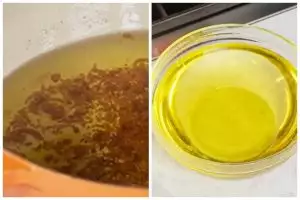Brilio.net - After frying fish, chicken, bakwan, cassava, etc., the cooking oil usually turns dirty. This can happen because bits of spices or batter from fried food fall to the bottom of the pan. Over time, the flakes of stain will burn and turn black when exposed to the high heat of the stove fire.
The easiest way to clean cooking oil from burnt crust fragments is to filter it. However, sometimes the filter is still not effective in preventing very small burnt crusts. That's why many people try tricks about cleaning cooking oil with certain ingredients.
One trick you can try is adding ginger and frying it for a few moments. This trick is known to make burnt crust flakes stick to the ginger . However, if you don't have ginger stock at home, don't worry because there is still one more trick from the YouTube account user America's Test Kitchen.
Tricks to clear cooking oil.
So, before practicing this trick, prepare a bowl filled with water first. Then, dissolve the cornstarch in the water. Yup, cornstarch is the main ingredient for practicing this trick to clear cooking oil. Stir until all the flour is dissolved in the water.
Then, immediately pour the cornstarch solution into the pan containing the dirty cooking oil. When adding the flour solution, make sure the oil is still cold. After that, stir gently using a spatula.
While stirring, then turn on the stove. Use very low heat so that the oil doesn't boil easily. Keep stirring until the cornstarch solution thickens.
"This will attract and trap the solids for easy removal (This cornstarch solution will attract and trap burnt crust, so that the oil can be cleaned)," emphasized the owner of the YouTube account America's Test Kitchen, quoted by BrilioFood .

photo: YouTube/America's Test Kitchen
Turn off the stove heat when all the burnt crust has managed to stick to the cornstarch. Next, strain the oil to separate it from the remaining crust and cornstarch. If so, the cooking oil can be used again for cooking.
The owner of the YouTube account America's Test Kitchen also explained that this cooking oil should only be used repeatedly a maximum of 3 times, so that it doesn't harm your health.

photo: YouTube/America's Test Kitchen
How about it, is this trick really effective for cleaning cooking oil? Taking a peek at the comments column on the America's Test Kitchen YouTube upload which has received 1 million views, quite a few netizens felt helped or shared other techniques for purifying oil.
"The strainer + coffee filter is way easier. Just set aside and go about your day. This technique is way more work because you have to be there (It's easier to use a strainer + coffee filter. Can be left behind to do other things. Technique with flour it's more complicated because you have to wait)," added YouTube @Codiggity369.
"I just did this and it worked perfectly! Thank you! (I tried it and it worked! Thank you!)," exclaimed YouTube @adambeltran416.
How to deal with frozen oil stocks.
When stored in the kitchen, cooking oil stocks can freeze without us realizing it. This can happen due to changes in the temperature of the oil storage area or other things. Here's how to fix it so that the oil becomes liquid again.
1. Leave the cooking oil at room temperature.
If your cooking oil has frozen in the container, let the container sit at room temperature for a few hours so the oil begins to thaw.
2. Heat cooking oil.
Once the oil starts to melt, you can heat the oil. Use a large enough pot or frying pan and heat the oil at medium to high temperature. Make sure to monitor the oil so that it doesn't get too hot and cause a spark or even catch fire.
3. Strain the cooking oil.
Once the oil has been heated and liquid again, strain the oil. Use a clean filter or special cloth to filter the oil from any residue that may have settled during the freezing process.
4. Save the cooking oil again.
After filtering, you can store the oil again in a clean and airtight container for future use. Be sure to mark the storage date and replace oil that is used too often.
5. Avoid excessive repetition of freezing.
Try not to let cooking oil freeze repeatedly, as this can affect the quality and taste of the oil. If possible, store the oil at room temperature or in the refrigerator to slow down the repeated freezing process.

